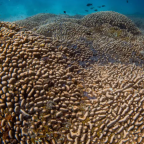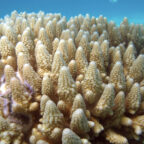
The ocean’s biggest challenge is a quiet menace. It is, like many other forms of pollution, caused by human activities. Its prevention is another challenge that will require major restructuring in lifestyle as well as governmental management. The problem: creating favor for one species over another. The cause: human waste.
“What are those red beards on the coral?” A diver asked when he got back aboard “Starfish Enterprise.” Captain Craig Smart dropped us on one of America’s most beautiful coral reefs situated a mile offshore of Delray Beach, Florida. It is a reef structure that runs parallel to the coast from about Miami to Jupiter. The reef is broken in places, more prolific in others and less defined the further north you go. The red beard is algae. It grows on coral, sponges and attached marine life with the result that it suffocates its host to death.
For coral to grow, warm, clear water is required. In general water temperature must be above 68 F without excessive silt, clear enough so that sunlight can penetrate. Coral is a colonial animal, not a plant. Some soft corals look like plants, waving wands and fans in myriad colors underwater, but they are animals. Life for coral begins as a free-swimming planula larvae that eventually settles on substrate underwater and begins to secrete calcium carbonate for its home. Colonies can develops asexually as new polyps bud off the old or divides by fission.
Inside coral, living in a commensal relationship, are zooxanthelae. This is a one-celled plant species that grows inside polyps. Plants produce oxygen using sunlight. Zooxanthelae help coral digest food to produce calcium carbonate. These microscopic plants give corals an advantage to grow. Without light plants die. Without zooxanthelae coral will eventually sicken and die.
The species I have discovered, in a cocktail of algae that menace Florida’s reefs, include Geramium, the red colored alage and Lyngbia, a blue green algae. The algae look like tremendous red beards hanging on coral underwater. Under a microscope they are blue green rods.
When ocean currents and wind action are strong, algae is seen in the water column drifting with the current. It eventually settles and drapes over coral, a convenient anchoring spot. The algae mass covers coral and sponges preventing coral polyps from extending their tentacles to feed. The mass blocks sunlight to zooxanthellae.
Nitrogen is a nutrient for algae. Nitrogen, in all of its forms, comes from various sources prevalent in human habitation and activity in Florida. The first is sewage waste. This includes direct dumping of sewage effluent into the ocean as well as treated sewage. While court rulings have ordered municipal sewage treatment facilities to close their ocean pipes, this has not happened.
Removal of nitrogen from sewage effluent is a very costly process. Few municipal budgets can afford the changeover. Many claim that the requirement to divert sewage effluent underground in deep-well injection is already a financial burden. When heavy rains occur sewage treatment facilities bypass deep-well injection and continue to pump sewage into the ocean through their “closed” pipes that run a mile underwater out to the reefs.
All water that comes to earth from rain and run-off from all manner of human activities eventually finds its way into storm drains. In Florida, where the land is flat and is composed of sand with a limestone base and geology, run off creates major pollution problems. Recently, signs have been posted on storm sewers that read “No dumping. Drains into Lake Worth.” Or into whatever waterway is convenient to get rid of the water.
Evaporation also brings high nitrogen loaded rain back to earth. Elements that evaporate do not disappear into outer space and remain gone forever as some would hope. Evaporated liquids are retained in clouds until rainfall occurs. Florida is a major cattle and animal feedlot. Animal waste evaporates. Some is drained and efforts are made to treat it. Evaporation causes it to remain in clouds then return to earth in rain.
Everything else that is put on Florida’s lawns and golf courses likewise washes off and ends up in storm drains with tropical rains. Signs that proclaim danger to humans and animals and warn not to walk on sprayed lawns make the danger obvious. Compound that posted danger by the fact that all of it, in one way or another, ends up in the environment. Run off goes into storm drains, then into the Intracoastal Waterway. At tide change it is carried out into the ocean. Consider that in Florida all lawns consist of two inches of sod grass with imported top soil placed atop sand and limestone substrate. Anything that soaks down goes into the water table somewhere.
In Florida the sugar industry has been blamed for creating vast wastelands of ocean and estuarine areas. The culprit has been nitrogen rich fertilizers and sprays used to make sugar cane grow. Sugar growers have been cooperating with government but the impact on Florida Bay and other critical marine areas have been evident by coral death and underwater wastelands. Algae is the culprit. Inland run offs of pesticides and herbicides used in many forms of agriculture including citrus, have created harm to the environment in many ways.
Water managers control a vast system of canals across Florida. In the coastal region the waters of Lake Okechobee are controlled by the U.S. Corps of Engineers and the South Florida Water Management District.
Lake Okeechobee is dammed to retain water. With the influx of people into Florida and widespread development in western areas that were once everglades and swamps, water managers have been given the task of preventing flooding that would devastate homes and shopping centers. These areas were developed after swamps and wetlands were drained. They stay dry only because water is retained in the lake and controlled by canals.
When it rains too much, water managers open canal gates and the water pours into the Intracoastal Waterway thence into the Atlantic Ocean. Canal water contains the nitrogen burden of agriculture, human and animal waste that directly affects algae growth.
Nitrogen rich waste is food for algae. The marine plants thrive and grow in such abundance that they choke other forms of life. Gorgonian soft corals, like sea fans and many other varieties of soft corals, have been killed along with other species. The result is that divers remark that once magnificent and pristine South Florida reefs look dead.
The preventative solution could have been taken many years ago. It is not that officials didn’t know that harm would be caused to the marine environment by dumping sewage and agricultural waste into the ocean. Government, with greedy developers, decided on their juggernaught without adequate planning to handle the amount of waste that would be produced by all of these people and their ancillary activities.
A byproduct of development is that people require water. Florida has been in drought for many years. While water managers throw fresh water away to respond to a need to prevent flooding over-developed swamp and everglade areas, they have not provided adequate storage of potable water for increased population.
“The reef here comes up twenty feet off the bottom. Look under the coral ledges. You’ll see sea turtles resting under there and all kinds of marine life. Delray Ledge is one of the most beautiful reefs in the world,” Captain Craig Smart told his divers. Unfortunately algae is killing coral on this and other reefs.
A second dive was made just south of the Boynton Beach Inlet. The reef, like others in the chain, is about a mile offshore. Inlet dredging, with an automatic boom to keep the channel clear, throws out murky muck in the county’s Inlet Park Beach south of the jetty. It is not a pleasant sight for bathers and beach goers but the channel will sand up if it is not dredged. This drainage ditch, from Intrtacoastal to the Atlantic, was never designed as a passage out into the ocean for boats. The inlet, as yellow warning signs proclaim, is drainage for the Intracoastal Waterway. Without drainage at tide change the Intracoastal would be a noisome, polluted sewer.
The reefs near the Boynton Inlet have been hard hit with algae. Coral is dead. Marine life has decreased food supply. Marine turtles return to this area every winter to mate then lay eggs on Florida’s beaches to continue the chain of life that has been going on for eons. Sponges and other food turtles eat are covered with algae. The chain of life is being adversely affected.
Eventually all waste water will have to be processed in ways in which nitrogen and other damaging elements are removed before it is dumped into the ocean. It is a costly process to implement. Meanwhile the 900 million or so gallons of sewage produced every day in Palm Beach County has to go somewhere.
It was only one diver that voiced concern after surfacing. Had a ship containing oil broken apart, had an oil rig cracked causing oil to wash up on shore, the outcry would have come from many voices. The quiet menace of algae pollution is unseen save by a few divers and unreported except through dedicated environmental organizations. Their message goes unheeded as uncritical. If life in South Florida is to be enjoyed by future generations then systems must be put in place to preserve this last frontier, the only reef structure in the Continental U.S.















Social Profiles